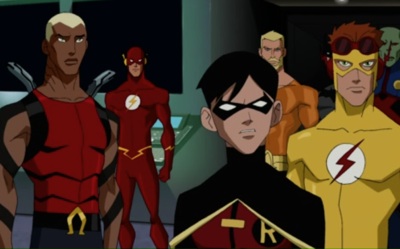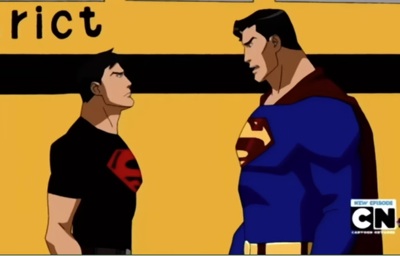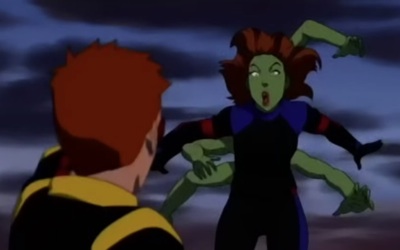The Cartoon Network has previously taken on DC Comics superteams with the Justice League and Teen Titans. Justice League Unlimited was the last installment of Paul Dini’s run at the helm of the DC Animated Universe, and it was a relatively mature and serious take on the superhero genre, while Teen Titans was much more lighthearted. The latest adaptation of the DC Universe on that network is Young Justice, which is loosely based on the comic book of the same name, but also has many elements of recent Teen Titan comics, as well as some original characters and interpretations. Judging from the first six episodes which all serve to introduce the main characters on the team, the show is off to a good start, especially for teen viewers.
It operates off a premise that DC Comics has batted around
for decades: “What if all of the sidekicks got together and fought evil in a
sort of Junior Justice League”?
It’s a great for subverting many ideas of the superhero genre; these are
imperfect heroes, still learning to use their powers, emotionally uncertain,
and not yet sure of their identities.
The kids in Young Justice are far more human than the gods and icons of
the Justice League, and it gives writers much more room for the cast to grow,
both literally and emotionally.
That cast started out small, just Robin, Aqualad and Kid
Flash (This a nod to the first Junior Justice League story from the 60’s). Quickly, they met Superboy, a clone of
Superman, along with Martian Girl (The Martian Manhunter’s niece), and
Artemis. Artemis and Aqualad are
both original characters; this interpretation of Aqualad was created just for
the show, although a similar character has been added to various DC comics. Artemis is Green Arrow’s sidekick,
she’s rather similar to Arrowette from the comic books, and shouldn’t be
confused with Artemis the Amazon from the Wonder Woman comics- although there
may be a plot twist coming about her origin.
Rounding out the cast is Red Arrow, formerly codenamed “Speedy” as Green Arrow’s sidekick. He’s grown tired of being treated like a kid and has decided to strike out on his own, so he isn’t technically part of the team. He’s more of a moody, rebellious rogue who pops in to help out when he can. This subplot has slowly played out over the course of the first six episodes, and it is part of a wide-ranging theme on the show about youthful rebellion. Both Red Arrow and Superboy are all sulky and brooding due to issues with their mentors. Superman is a little out of character in his dealing with Superboy. Granted, almost anyone would be freaked out by meeting an unknown teen clone (A metaphor for real-world absentee fathers, no doubt), however, you’d think that a paragon of goodliness like Superman would handle this situation with a little more sensitivity to his youthful clone. I suspect that all of this angst, and moping will appeal to teen viewers, but as a grown-up I found it wearying. A single character as the designated “Broody Guy” is fine; the show doesn’t need two or more.

Speaking of “Designated Broody Guy”, the show occasionally treats the various characters as Smart Guy, Strong Guy, Fast Guy, The Leader, and The Chick. Miss Martian is coming dangerously close to be the token girl character who is just around to be pretty and have a crush on the cool Broody Guy. Her Martian powers have been toned down; in DC comics, a Martian has super-strength, can shoot energy beams out of their eyes, and many other abilities. In the cartoon, Miss Martian hasn’t demonstrated super-strength or eye beams, and the writers even specifically pointed out that she can’t use the Martian power of intangibility, and has trouble with some shape-changing. All of this rings of concern that the producers don’t want a girl to be the most powerful member of the team. In fact, her powers of Telepathy, Invisibility and Telekinesis make her sound like a pastiche of Jean Gray and Sue Storm during the Sixties when they were the token girls on the X-Men and Fantastic Four. I’m also growing tired of her constantly spouting the catchphrase “Hel-loo Megan”.

What the writers do well is make sure that the spotlight is rotated to a different character in each episode. Megan got her own episode soon after the pilot, Superboy learned a valuable lesson from Black Canary, and a whole episode was dedicated to Artemis (Of course the opening credits spoiled the secret of the mysterious archer who saves Kid Flash in episode five).
Judging by these first few episodes, the show has much
potential. While there are some
troubling elements regarding character development, there’s also plenty of
action, the art and animation are excellent, and the storylines are deep enough to keep older viewers
interested. Plus, almost every
episode has a cameo by an obscure DC Comics character, so dedicated fans can
play Name That Villain each week.
Read our review of the next episode Denial.